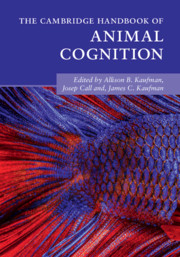Book contents
- The Cambridge Handbook of Animal Cognition
- The Cambridge Handbook of Animal Cognition
- Copyright page
- Dedication
- Contents
- Figures, Tables, and Boxes
- Contributors
- Acknowledgments
- Introduction
- Part I Communication and Language
- Part II Memory and Recall
- 6 Memory and Recall Overview
- 7 A Fish Memory Tale
- 8 Memory in Hummingbirds
- 9 Event Memory in Rats
- 10 Primate Recall Memory
- Part III Social Cognition
- Part IV Social Learning and Teaching
- Part V Numerical and Quantitative Abilities
- Part VI Innovation and Problem-Solving
- Index
- References
7 - A Fish Memory Tale
Memory and Recall in Fish and Sharks
from Part II - Memory and Recall
Published online by Cambridge University Press: 01 July 2021
- The Cambridge Handbook of Animal Cognition
- The Cambridge Handbook of Animal Cognition
- Copyright page
- Dedication
- Contents
- Figures, Tables, and Boxes
- Contributors
- Acknowledgments
- Introduction
- Part I Communication and Language
- Part II Memory and Recall
- 6 Memory and Recall Overview
- 7 A Fish Memory Tale
- 8 Memory in Hummingbirds
- 9 Event Memory in Rats
- 10 Primate Recall Memory
- Part III Social Cognition
- Part IV Social Learning and Teaching
- Part V Numerical and Quantitative Abilities
- Part VI Innovation and Problem-Solving
- Index
- References
Summary
Fishes offer fantastic systems in which to study the evolutionary drivers of cognition because they comprise more than 30,000 species occupying a diverse range of habitats. Many researchers have taken advantage of this diversity to examine the ecological correlates of brain morphology and learning, but memory abilities per se are still fairly understudied compared to terrestrial vertebrates. Here, we review studies that have examined memory retention in fish, sharks, and rays and summarize the mechanisms of regulation of memory in these groups. Mechanisms of memory regulation are similar to those of terrestrial vertebrates, and it is clear that they can retain information from several days, months, and even years. We also address the potential for episodic-like memory in fish, which appears to be on par with evidence from other nonhuman vertebrates, further suggesting the process of memory retention is conserved across all vertebrates. In the last section of this review, we discuss avenues of memory research in which fish have been given little attention and highlight areas of future investigation.
- Type
- Chapter
- Information
- The Cambridge Handbook of Animal Cognition , pp. 140 - 173Publisher: Cambridge University PressPrint publication year: 2021



